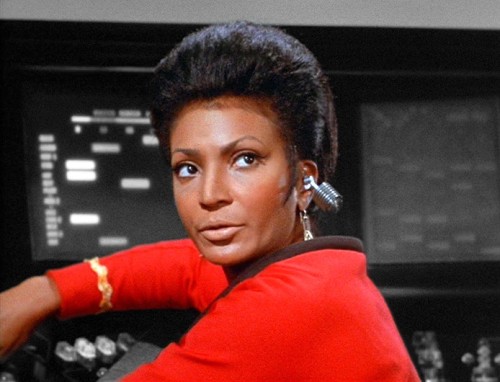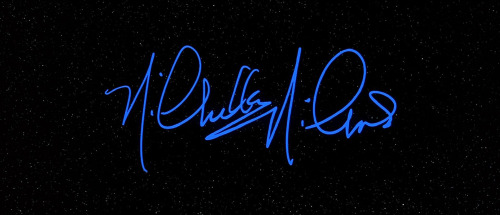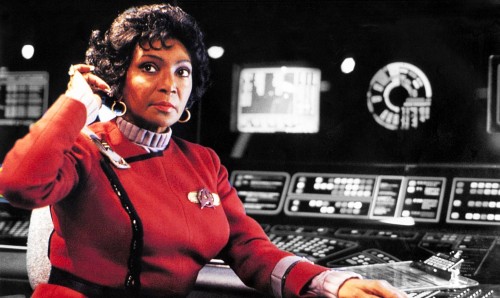This Is The Best Thing Ever!
This is the best thing ever!
Luke Skywalker in The Mandalorian but it’s Toxic by Britney Spears
More Posts from Athenadonovan and Others
Yay!

Fucking yes.

Various Starfleet-issued hand weapons from Star Trek The Original Series, the first six films, The Next Generation, and the Kelvin-timeline.

Susan Blase aka Black Eyed Suzy (American, based Bear Gap, PA, USA) - The Tide is High, 2016, Photography

Remembering Leonard Nimoy. 🖖





Star Trek: Phase 2 Enterprise launch
via The Light Works
Now I have to have this
Star Trek Missing Scenes 1
I got this book recently and I highly recommend it.

Most of the scenes in it were filmed but then cut for time. I thought I’d share some of the highlights from certain episodes. Many are very revealing and/or just delightful. Apologies for the poor photography.
I, Mudd. When they are being held by the androids and discussing their options. Chekov contributes this fact:


By Any Other Name. When Scotty is getting Tomar drunk. Ever wonder what set up the “It’s green” liquor joke?


Elaan of Troyius. A lovely exchange between Spock and Uhura in a party scene that SHOULD NOT HAVE BEEN CUT!


The Immunity Syndrome. When the ship is stuck in the black void of the amoeba. A beautiful scene between Bones and Christine that again, never should have been anywhere near the cutting room floor.


To be continued in my next post……
She was truly a pioneer and she will be missed. 😢





To the woman that inspired countless girls and people of color, we will never forget you.
You will always be in our hearts.
Thank you for going where no woman had gone before.
Nichelle Nichols 1932- 2022
Never noticed this while watching clone wars.


Weird and Wonderful Irregular Galaxies
Spiral and elliptical galaxies seem neatly put together, but what happened to irregular galaxies? Irregular galaxies have one-of-a-kind shapes and many look like blobs! Why do they look the way they do? Astronomers think the uniqueness of these galaxies results from their interactions with other galaxies — like when they pass close to one another or even collide!

Looking back at the early universe with the help of our Hubble Space Telescope’s “deep field” observations, astronomers can peek at galaxies millions and billions of light-years away. They noticed that these far-away galaxies appear unusually messy, showing more star formation and mergers than galaxies closer to the Milky Way.

We also see irregular galaxies closer to home, though. Some may form when two galaxies pass close together in a near-miss. When this happens, their gravity pulls stars out of place in both galaxies, messing up the neat structure they originally had as spiral or elliptical galaxies. Think of it like this: you happen to have a pile of papers sitting at the edge of a table and when someone passes close by the papers become ruffled and may scatter everywhere! Even though the two galaxies never touched, gravity's effects leave them looking smeared or distorted.

Some irregular galaxies result from the collision between two galaxies. And while some of these look like a blob of stars and dust, others form dazzling ring galaxies! Scientists think these may be a product of collisions between small and large galaxies. These collisions cause ripples that disturb both galaxies, throwing dust, gas, and stars outward. When this happens, it pushes out a ring of material, causing gas clouds to collide and spark the birth of new stars. After just a few million years, stars larger than our Sun explode as supernovae, leaving neutron stars and black holes throughout the ring!

Not all galaxy collisions create irregular galaxies — our Milky Way spiral galaxy has gone through many mergers but has stayed intact! And for some interacting galaxies, being an irregular galaxy may just be a phase in their transformation. We’re observing them at a snapshot in time where things are messy, but they may eventually become neat and structured spirals and ellipticals.

Irregular galaxies are similar to each other, but unique and beautiful because of their different interactions, whether they’re just passing another galaxy or taking part in a dramatic collision. Keep up with NASA Universe on Facebook and Twitter where we post regularly about galaxies.
Make sure to follow us on Tumblr for your regular dose of space: http://nasa.tumblr.com.
-
 q-kanbas reblogged this · 4 days ago
q-kanbas reblogged this · 4 days ago -
 thunderdone reblogged this · 5 days ago
thunderdone reblogged this · 5 days ago -
 cordeliariel reblogged this · 5 days ago
cordeliariel reblogged this · 5 days ago -
 cordeliariel liked this · 5 days ago
cordeliariel liked this · 5 days ago -
 garlickedbreads reblogged this · 5 days ago
garlickedbreads reblogged this · 5 days ago -
 garlickedbreads liked this · 5 days ago
garlickedbreads liked this · 5 days ago -
 silversong79 reblogged this · 5 days ago
silversong79 reblogged this · 5 days ago -
 insanity6666 reblogged this · 5 days ago
insanity6666 reblogged this · 5 days ago -
 insanity6666 liked this · 5 days ago
insanity6666 liked this · 5 days ago -
 verypuppychaos reblogged this · 6 days ago
verypuppychaos reblogged this · 6 days ago -
 roguetelepath reblogged this · 1 week ago
roguetelepath reblogged this · 1 week ago -
 janusfranc15 reblogged this · 1 week ago
janusfranc15 reblogged this · 1 week ago -
 janusfranc15 liked this · 1 week ago
janusfranc15 liked this · 1 week ago -
 just-interested1767 liked this · 1 week ago
just-interested1767 liked this · 1 week ago -
 isafoxfire liked this · 1 week ago
isafoxfire liked this · 1 week ago -
 ultamitecrusader-blog liked this · 1 week ago
ultamitecrusader-blog liked this · 1 week ago -
 inthuu liked this · 2 weeks ago
inthuu liked this · 2 weeks ago -
 catsiren liked this · 2 weeks ago
catsiren liked this · 2 weeks ago -
 surohsopsisofclouds liked this · 2 weeks ago
surohsopsisofclouds liked this · 2 weeks ago -
 h-didanart reblogged this · 2 weeks ago
h-didanart reblogged this · 2 weeks ago -
 h-didanart liked this · 2 weeks ago
h-didanart liked this · 2 weeks ago -
 welcome-to-the-landfill liked this · 2 weeks ago
welcome-to-the-landfill liked this · 2 weeks ago -
 high-priestess-of-the-desert liked this · 2 weeks ago
high-priestess-of-the-desert liked this · 2 weeks ago -
 cocolovesorcs liked this · 2 weeks ago
cocolovesorcs liked this · 2 weeks ago -
 circesays reblogged this · 2 weeks ago
circesays reblogged this · 2 weeks ago -
 circesays liked this · 2 weeks ago
circesays liked this · 2 weeks ago -
 boredandblank reblogged this · 2 weeks ago
boredandblank reblogged this · 2 weeks ago -
 whenyoucantwritesoyoudrawinstead reblogged this · 2 weeks ago
whenyoucantwritesoyoudrawinstead reblogged this · 2 weeks ago -
 danielle-may-song-harkness liked this · 2 weeks ago
danielle-may-song-harkness liked this · 2 weeks ago -
 dantetome liked this · 2 weeks ago
dantetome liked this · 2 weeks ago -
 lethargicleo liked this · 2 weeks ago
lethargicleo liked this · 2 weeks ago -
 iquarent liked this · 2 weeks ago
iquarent liked this · 2 weeks ago -
 brimstonetaco reblogged this · 2 weeks ago
brimstonetaco reblogged this · 2 weeks ago -
 heckthatbork reblogged this · 2 weeks ago
heckthatbork reblogged this · 2 weeks ago -
 the-pandorabox liked this · 2 weeks ago
the-pandorabox liked this · 2 weeks ago -
 cqssqndrq liked this · 2 weeks ago
cqssqndrq liked this · 2 weeks ago -
 transsammie liked this · 2 weeks ago
transsammie liked this · 2 weeks ago -
 solarflaresdaddyissues reblogged this · 2 weeks ago
solarflaresdaddyissues reblogged this · 2 weeks ago -
 solarflaresdaddyissues liked this · 2 weeks ago
solarflaresdaddyissues liked this · 2 weeks ago -
 draculas-husband liked this · 2 weeks ago
draculas-husband liked this · 2 weeks ago -
 quiche-on-the-hellsite liked this · 2 weeks ago
quiche-on-the-hellsite liked this · 2 weeks ago -
 abundantchewtoys liked this · 2 weeks ago
abundantchewtoys liked this · 2 weeks ago -
 hemicnox liked this · 2 weeks ago
hemicnox liked this · 2 weeks ago -
 eternal-soup liked this · 2 weeks ago
eternal-soup liked this · 2 weeks ago -
 bucketofcrows reblogged this · 2 weeks ago
bucketofcrows reblogged this · 2 weeks ago -
 seraphim-seeker liked this · 2 weeks ago
seraphim-seeker liked this · 2 weeks ago -
 belleblossoms reblogged this · 2 weeks ago
belleblossoms reblogged this · 2 weeks ago



